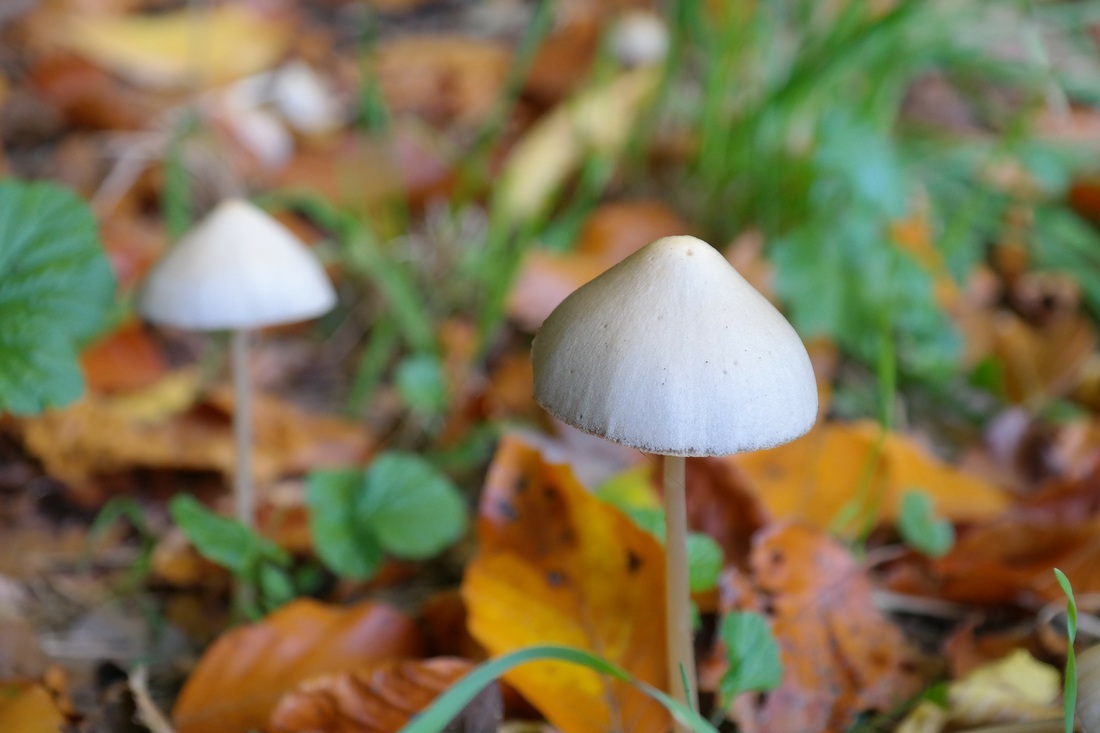|
11/1/2015
November Psilocybe pelliculosaPsilocybe pelliculosa is a species of fungus in the family Hymenogastraceae. The fruit bodies, or mushrooms, have a conical brownish cap up to 2 cm (0.8 in) in diameter atop a slender stem up to 8 cm (3.1 in) long. It has a white partial veil that does not leave a ring on the stem. American mycologist Alexander H. Smith first described the species in 1937 as a member of the genus known today as Psathyrella; it was transferred to Psilocybe by Rolf Singer in 1958.
Psilocybe pelliculosa is found in the Pacific Northwest region of the United States and Canada, where it grows on the ground in groups or clusters along trails or forest roads in coniferous woods. A single collection has also been reported from Finland. The mushrooms contain the psychedelic compounds psilocybin and baeocystin, although at relatively low concentrations. Several mushroom species that are similar in appearance to P. pelliculosa can be distinguished by subtle differences in the form of the fruit body, or by microscopic characteristics.The cap of P. pelliculosa is initially sharply cone-shaped, and expands slightly over time to become broadly bell-shaped, but it never expands to become completely flat. The cap margin is pressed against the stem initially, and for a short time is appendiculate (has partial veil fragments hanging from the margin). The caps of mature specimens are smooth, sticky, and have translucent radial striations that reach dimensions of 0.8 to 2 cm (0.3 to 0.8 in) in diameter. The color ranges from umber to isabella (dark dingy yellow-brown) when the mushroom is moist, and changes to pinkish-buff when dry. The cap margin can have a greenish-gray tinge. The cap cuticle is a thin gelatinous covering that can be peeled off.[3] The gills have an adnate attachment to the cap, are narrow to moderately broad, closely spaced, and eventually separate from the stem. Young gills are cinnamon-brown in color, with lighter edges, but darken in maturity because they become covered with the dark spores. The stem is 6 to 8 cm (2.4 to 3.1 in) long by 1.5 to 2 mm (0.06 to 0.08 in) thick, and roughly equal in width throughout except for an slightly enlarged base. The lower region of the stem is brownish in color and has silky "hairs" pressed against the stem; the upper region is grayish and pruinose (lightly dusted with powdery white granules).[3] The flesh turns slightly bluish or greenish where it has been injured.[5] The application of a drop of dilute potassium hydroxide solution on the cap or flesh will cause a color change to pale to dark yellowish- to reddish-brown; a drop on the stem produces a less intense or no color change.[8] The spore print is purplish-brown.[11] Under the microscope, the spores appear dull purple-brown. They are ellipsoid to somewhat egg-shaped, and, according to Singer's original description, measure 8–10 by 4–5 μm.[3] A later study of specimens collected from British Columbia, Canada, instead reported a larger spore size range of 10–13 by 6–7 μm.[12] The spores have an apical germ pore.[5] The basidia (spore-bearing cells) are four-spored, hyaline (translucent), and measure 22–35 by 7–10 μm.[8] There are abundant cystidia that form a sterile band on the edges of the gills (cheilocystidia); these cystidia are smooth, inflated, and fusoid-ventricose (enlarged in the middle and tapered toward both ends) with an sharp tip, and measure 25–30 by 6–9 μm.[3] The cap cuticle (an ixocutis) is made of a layer of roughly horizontal, gelatinized, wavy, hyaline hyphae that are 0.8–5.5 μm in diameter. Wikipedia |
|
If You Suspect a Poisoning
If you suspect you have consumed a poisonous mushroom, contact a physician, the closest hospital ER, poison control center, or dial 911, depending on the severity of the reaction. US Poison Control: 1-800-222-1222 The North American Mycological Association (NAMA) has information that may also be of help. Click here. We do not ID mushrooms through this website.
If you are in need of an ID consider uploading quality photos with multiple views of your specimen and descriptions of your find to Mushroom Observer or iNaturalist including our projects or post in Wild Food Wisconsin or Mushroom Identification Group. If you contact us and provide a way to get back to you, we may be able to provide suggestions for more identification resources you can use. You are always responsible for your own decisions taken on the basis of identification resources. |
Wisconsin Mycological Society (WMS) is dedicated to the study and enjoyment of mushrooms and other fungi throughout the state of Wisconsin. Education, safety, sustainability, community, and connecting with nature are our goals.
|


 RSS Feed
RSS Feed
